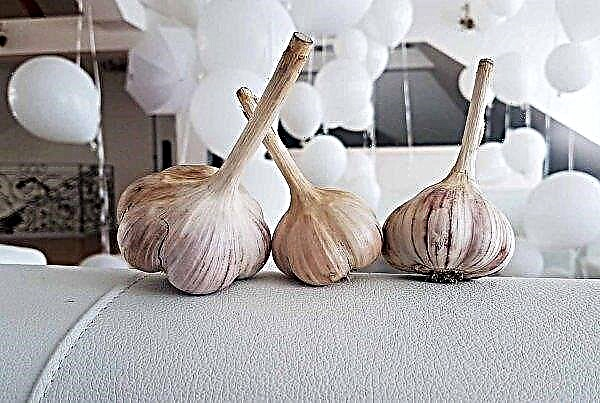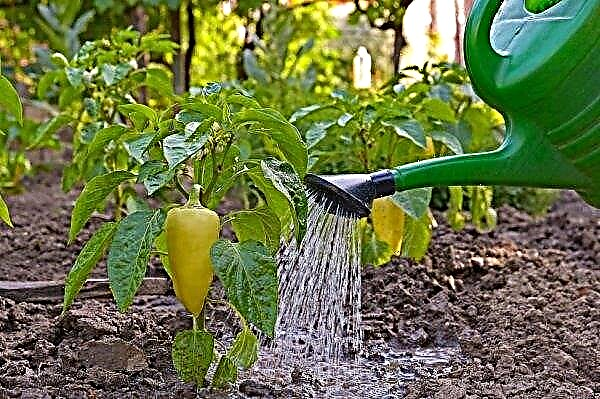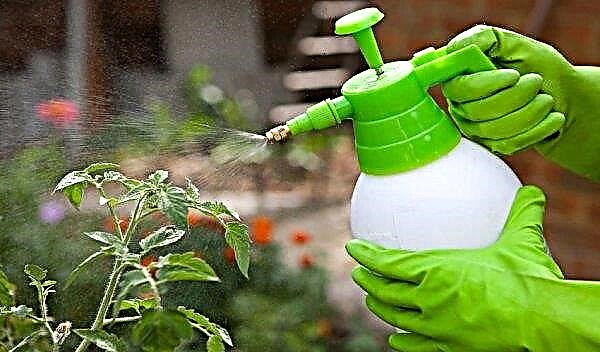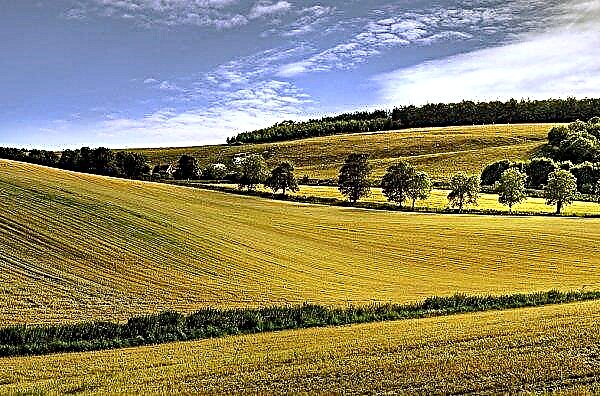For owners of household plots that are engaged in growing vegetables, the polycarbonate greenhouse “Kapelka” will be the best solution, which, thanks to its shape and reliable coating material, can withstand any climatic conditions. Often, vegetable farmers acquire a similar design in finished form, but there are those who prefer to make a greenhouse with their own hands. How? Let's figure it out.
Did you know? The largest in the world is the British greenhouse, called the Eden. It represents a whole complex, in the form of numerous inflatable pentagonal cells with steel frames, in which plants from all over the planet are represented. The opening of the building took place in 2001, it took 2.5 years to build it.
Features and characteristics of the greenhouse "Droplet"
Greenhouse “Droplet” is a reinforced, closed-type structure made of polycarbonate, the shape of which, in the form of a large drop, was specially developed by specialists, taking into account the peculiarities of the winter period. Such a constructive solution does not allow the snow mass to linger on the surface and protects the greenhouse from strong gusts of wind.
Pros
- In addition to its unconventional form and high reliability, the greenhouse has the following advantages:
- structural strength achieved through the use of a reinforced frame consisting of metal arcs capable of withstanding strong winds, withstanding high surface loads in the form of snow;
- long term of operation and practicality in application;
- the ability to extend the building to the desired length, due to the installation of additional steel arcs;
- the possibility of zoning the internal space through special partitions;
- simplicity and efficiency in assembly;
- the ability to correctly control the temperature indicators inside the structure, thanks to the presence of doors with windows;
- versatility in use, since it is perfect for growing vegetable and fruit plants;
- excellent sealing, lack of cracks and gaps due to the fact that the dimensions of the frame are optimized for the dimensions of a polycarbonate sheet.
Minuses
- If we talk about the shortcomings of "Droplets", then experienced vegetable growers note:
- low construction height, which makes growing tall crops an extremely difficult task;
- lack of tightness on the ridge.
How to make a greenhouse "Droplet" do-it-yourself from polycarbonate
On the market today are models of greenhouse “Droplet” of various domestic and foreign manufacturers. However, many summer residents make designs themselves, with their own hands, using improvised materials.
Important! When assembled, the finished greenhouse has dimensions: height - 240 cm, width - 300 cm. The length of the structure can vary from 400 cm to 1200 cm.
Dimensioning and drawing creation
First of all, the construction of a greenhouse begins by creating a drawing and determining the desired dimensions. Fully finished drawings everyone has the opportunity to find on the Internet. As a rule, in such schemes the main details of the structure, its dimensions are already indicated, the volumes of materials are calculated. Based on these data, you can easily calculate the required number of building materials required for the construction of supporting elements and coatings. The simplicity of manufacturing "Droplets" lies in the fact that its width (300 cm) and height (240 cm) remain unchanged, regardless of the length of the product. In turn, the length of the greenhouse is arbitrary and will depend on the individual preferences of the owner.
The simplicity of manufacturing "Droplets" lies in the fact that its width (300 cm) and height (240 cm) remain unchanged, regardless of the length of the product. In turn, the length of the greenhouse is arbitrary and will depend on the individual preferences of the owner.
Preparation and site selection
Just before you collect the greenhouse, you need to decide on its location. Experts recommend choosing a fairly even, well-lit area, with a depth of at least 2.5 m of underwater. If necessary, the soil where the structure is to be installed should be leveled in places where the polycarbonate sheets will be connected to the ground.
Did you know? The first greenhouse in Russia appeared during the reign of Peter I. However, similar designs were used as greenhouses for growing exotic flowers. After several decades, in greenhouses began to grow vegetables and fruits.
Step-by-step assembly and installation instructions
Assembling and installing a polycarbonate structure in the shape of a “Droplet” is not particularly difficult if you strictly follow the recommendations of professionals:
- Foundation construction. The construction of the framework base is considered one of the most important stages of the preparatory work, on which the reliability of the entire structure will depend. The construction of the foundation begins with the marking of the soil to determine the size of the greenhouse. Next, the top layer of soil is removed according to the marking, the rest of the soil is well compacted. To prevent product subsidence during groundwater exposure, a small “pillow” of sand and gravel is laid.
- Construction of wooden formwork. Formwork will strengthen the structure, make it more reliable. For the manufacture of using wooden bars, a cross section of 10 × 10, which are fixed in the form of a frame.
- Assembly of the frame. The next step is the assembly of the frame from metal arcs and ends. For this, strong steel arcs are used, which are mounted at a distance of 60-65 cm from each other. To fix the arcs, ends, metal brackets, self-tapping screws or other fasteners are used on the foundation.
- Installation of additional elements. After assembling the frame, they begin to install additional components: doors with windows, modules.

Polycarbonate lining
The final stage of assembly is the laying of sheets of polycarbonate, which are pre-cut into the required number of parts, the required size. During the cladding, the polycarbonate is placed in an upright position, slightly bent so that the structure takes the form of a drop.
Important! Bending of polycarbonate sheets is carried out across the stiffeners, otherwise, cracks may form that will adversely affect the tightness of the product.
Before laying polycarbonate it is very important to check its quality. Preference should be given to sheets whose thickness is at least 4 mm. Also, upon purchase, experts recommend weighing the material: a standard sheet with dimensions of 600 × 210 cm should have a weight of more than 10 kg. Light weight indicates a lightweight version of the product, which is not distinguished by durability and high quality.
How to choose a greenhouse from the manufacturer: tips and tricks
Modern manufacturers offer consumers a wide selection of polycarbonate greenhouses. Before giving preference to one of the options, you should pay attention to some expert advice:
- The form. The design features of the greenhouse are determined not so much by aesthetic considerations as by functional ones. Droplet or arched products are considered optimal, which have an attractive appearance, provide snow toe due to the sloping roof, are convenient in caring for plants, and easy to install and dismantle.
- Wireframe. In order for the greenhouse to serve a sufficiently long period, you should choose products with a reinforced frame, in the manufacture of which longitudinal amplifiers were used. The design should consist of steel, galvanized, all-bent arcs, the distance between which should not exceed 60-90 cm. It is desirable that the frame had as few joints as possible and the pediments welded by the manufacturer.
- Coating material. Polycarbonate is most in demand, the main advantages of which are high strength, reliability, flexibility, a long service life, resistance to atmospheric phenomena, affordable cost. It is recommended to give preference to sheets with a width of at least 4 mm.

Features of greenhouse care
Polycarbonate is a modern, heavy-duty and durable material, the care of which does not require special effort and time. Nevertheless, high-quality maintenance of the greenhouse can significantly extend its service life. During operation of the structure, polycarbonate sheets should be cleaned regularly using ordinary soapy water and clean water.
Important! When cleaning polycarbonate, abrasive products must not be used, since they destroy the UV coating from the surface and reduce the strength of the sheet itself.
Shading of the walls is recommended by means of ordinary chalk. In autumn, it is necessary to remove all plant debris from the greenhouse, dig and loosen the soil, carry out major cleaning of the structure with its further disinfection. For the winter, the greenhouse must be completely "mothballed" if it will not be used.
Which greenhouse is better "Droplet" or arched?
At its core, a drip greenhouse is considered a better version of the arched structure. They are characterized by a minimal number of joints of coating material, which allows owners to significantly save money and time for additional sealing. In addition, such structures do not allow snow masses to accumulate on the surface and do not form condensate indoors. The only advantage of the arched greenhouse, compared with the drip, are large areas of the internal space.
In addition, such structures do not allow snow masses to accumulate on the surface and do not form condensate indoors. The only advantage of the arched greenhouse, compared with the drip, are large areas of the internal space.
Drip type greenhouses will be an ideal option for those vegetable growers who work in regions with harsh climatic conditions and a lot of rainfall in the winter. Such designs are characterized by reliability, durability, and subject to the simplest rules of care, they can last for many years.












